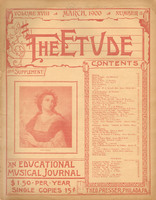BY JAMES M. TRACY.
How few think of the great ability and fecundity for writing piano studies and sonatas possessed by that once great pianist Clementi. Many students have worked at his preludes and exercises, his gradus and his sonatas, without giving the man any credit or thought of what his genius was doing for them.
Clementi was a perfect pianist in all that pertained to a finished technic and brilliancy of playing classical piano works. (He was not considered a genius, but a rare mechanic, capable of accomplishing untold difficulties on his instrument. He really perfected the action of pianos, making that a life-study.)
Next to Clementi, as a perfect pianist, was Hammel, who for some years occupied the foremost position before the world as the best pianist. Hammel, like Clementi, had perfect technic. It has been said of both these artists that they never played false notes, and never covered up the clear, crystal notes of scales and other passages, by the use of the pedal. For many years Hammel concertized over Europe, and held the enviable position as the best pianist in the world. He composed some good piano music, was court pianist at Weimar some years, amassed a small fortune, but was never anything but a cold, austere, cranky man.
Clementi, Czerny, and Hammel have furnished nearly all the technical exercises and studies used in educating the great artists, who, for years, have been astonishing the world with their wonderful playing.
Czerny, whose studies have been and are now used all over the world, was never a noted pianist, though he played fairly well. His life was given up to composition and educating those who have become the most famous pianists the world has ever seen: Liszt, Thalberg, Dreyschock, Mayer, Döhler, and others. All the noted pianists of the present time have been brought up mainly on Czerny’s studies. If such pianists as Liszt, Thalberg, and other world-wide known players have succeeded so well with Czerny’s studies, these studies must still be considered the ne plus ultra of their art. The most renowned teachers believe in and use them in their instruction to-day, notwithstanding there are those who cry them down.
The more modern composers of technical studies are Kohler, Löschhorn, and Heller, though the latter is more in the form of melodious studies. To students that find other masters’ studies irksome, or those who are not very fond of music or hard work, Heller furnishes them with pleasant interesting study.
Kohler is not interesting or musical in his compositions, in which respect he is far dryer and less educating than Czerny. Löschhorn has written a book of useful finger exercises, and many studies of a melodious and educating nature. There are other modern technical writers of which la Couppy is, perhaps, the best. With a large experience in teaching and contact with well-known pianists, I recall no one of prominence who has not made Czerny’s etudes a foundation for study. Rotated with Kohler, Löschhorn, Cramer, and Heller, one will most certainly find the road to superior excellence. Of course, to attain virtuosity, one must practice Chopin, Henselt, Kullak, Liszt, and Bach’s forty-eight preludes and fugues. From six to ten years of ceaseless labor of seven hours’ daily practice a person with talent may become a very good pianist. Work, work, work, will accomplish that end.



